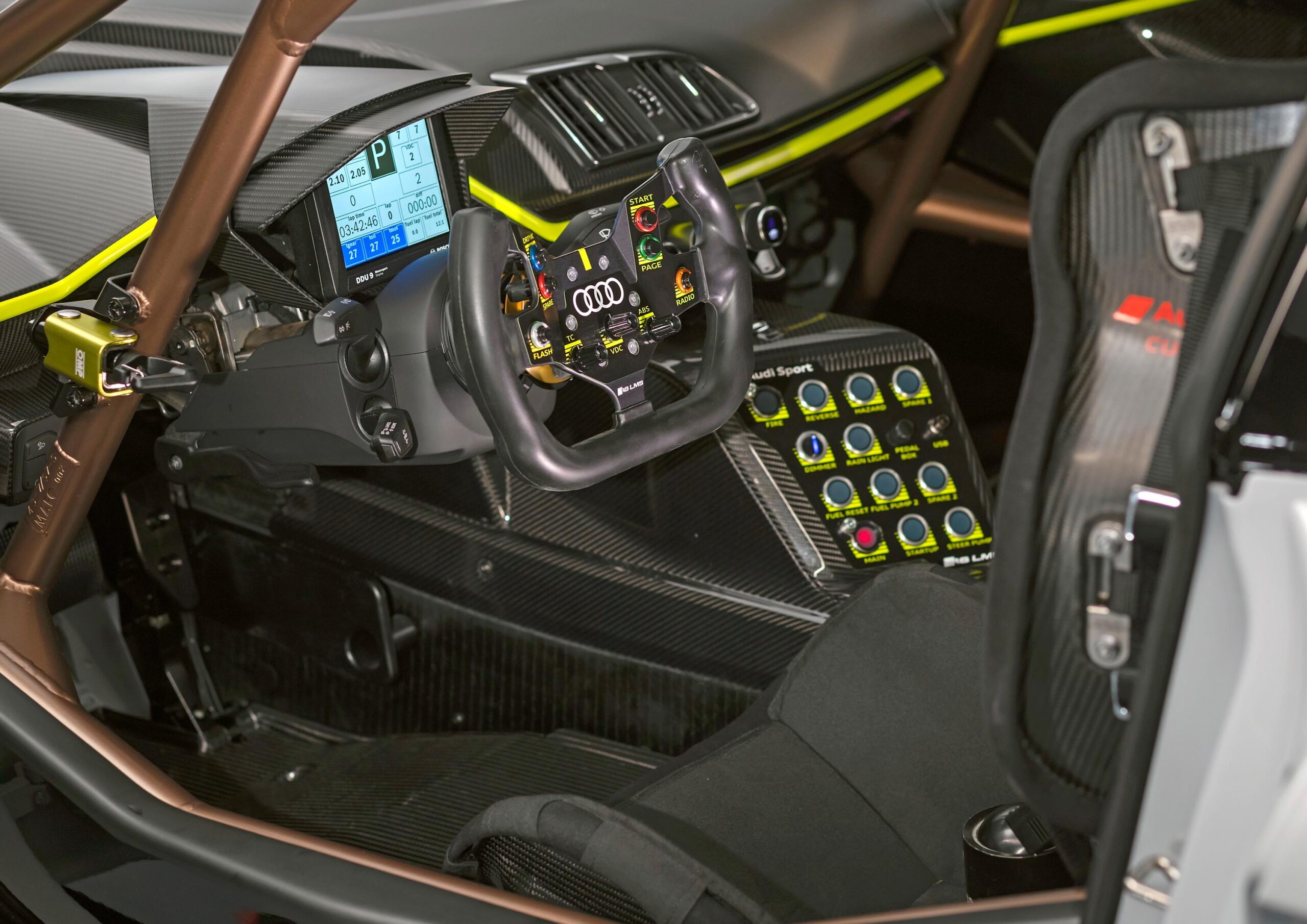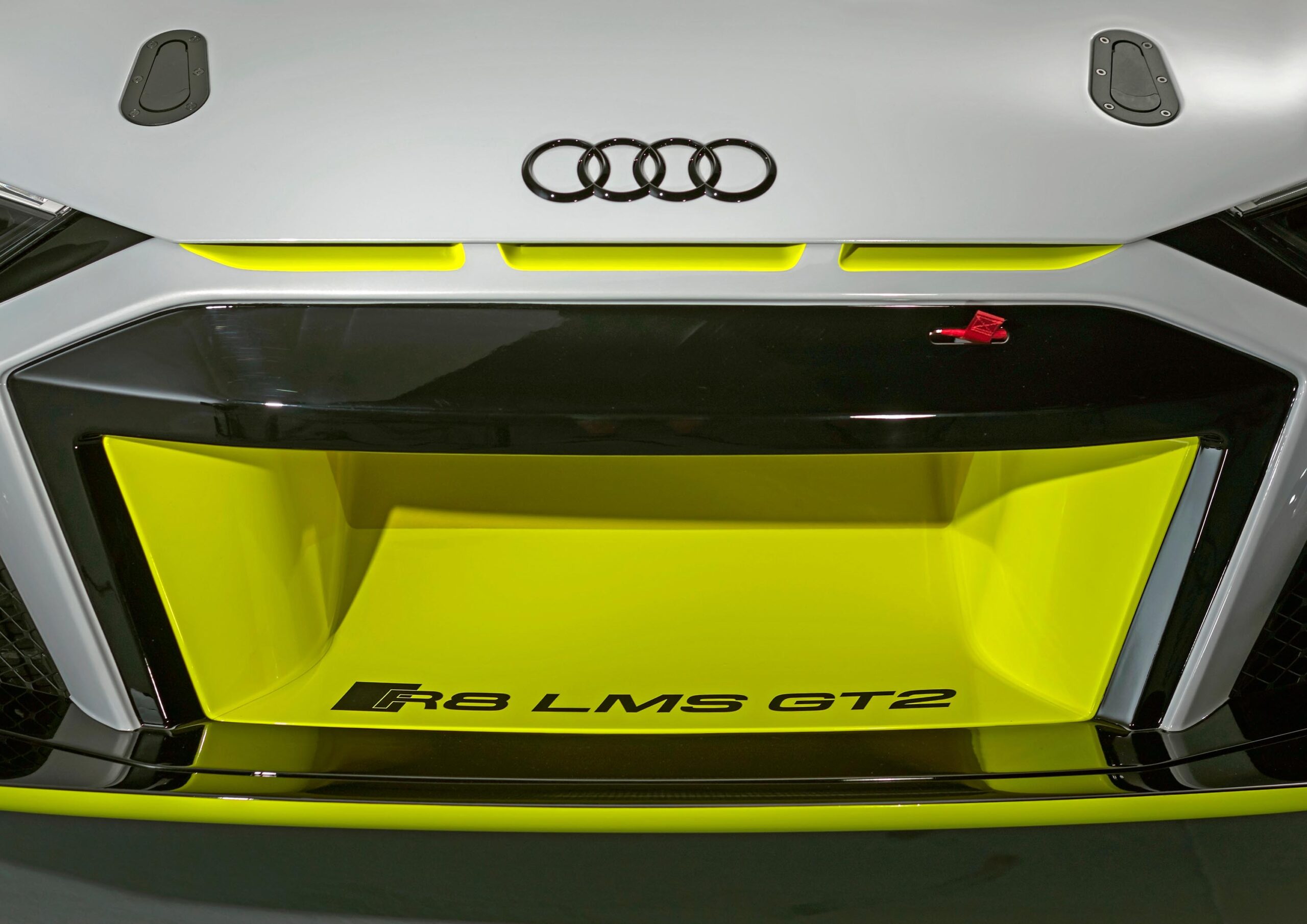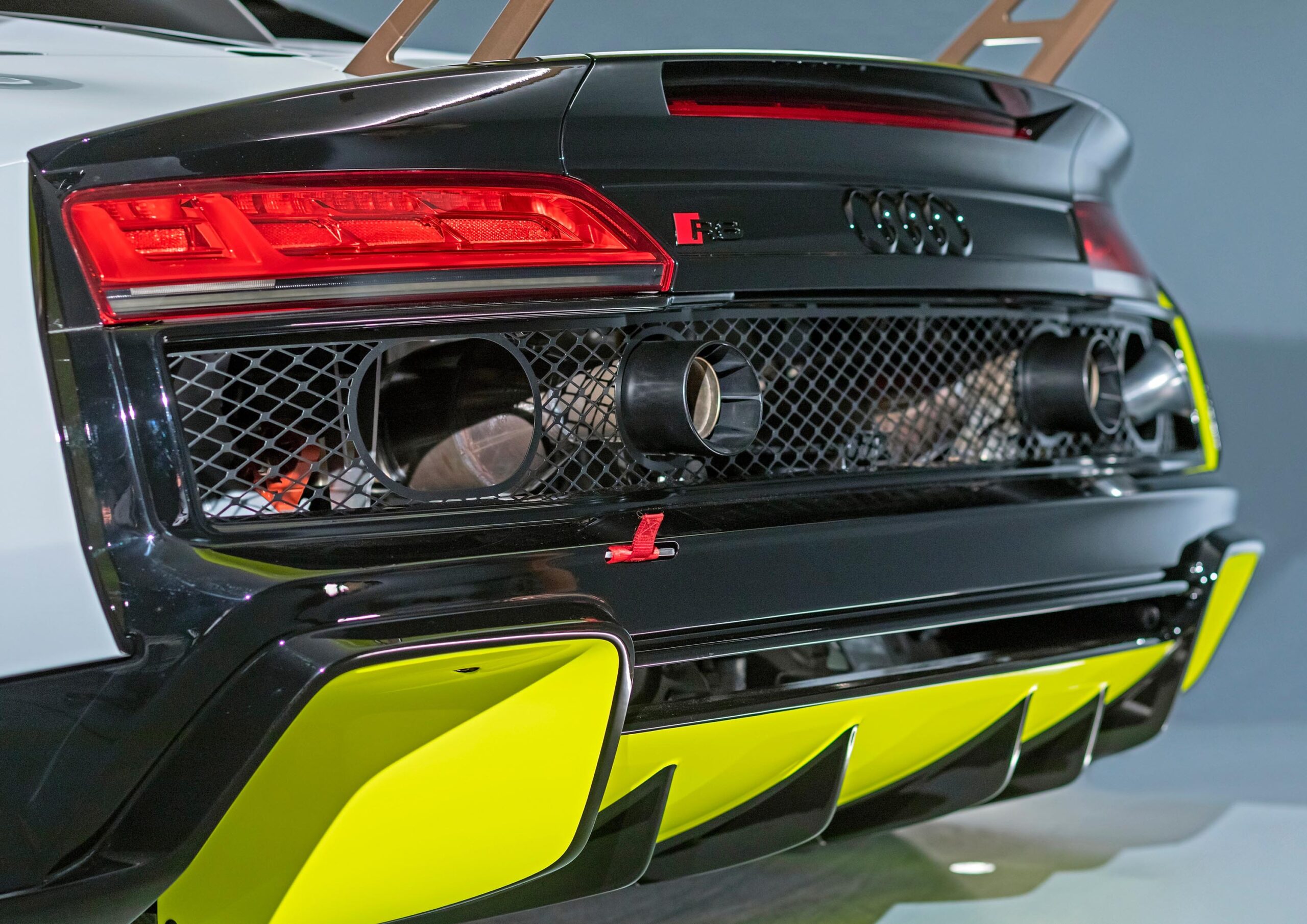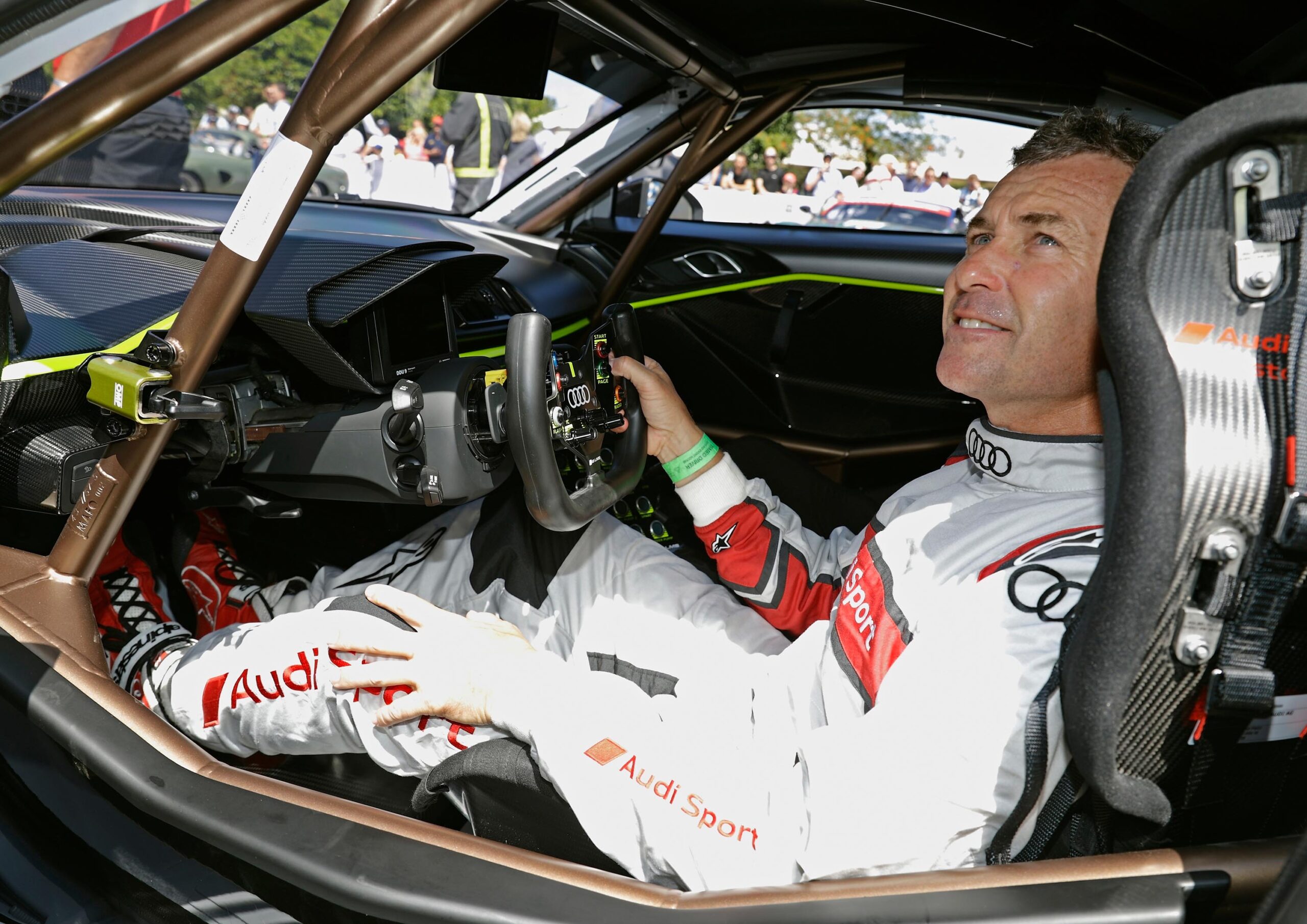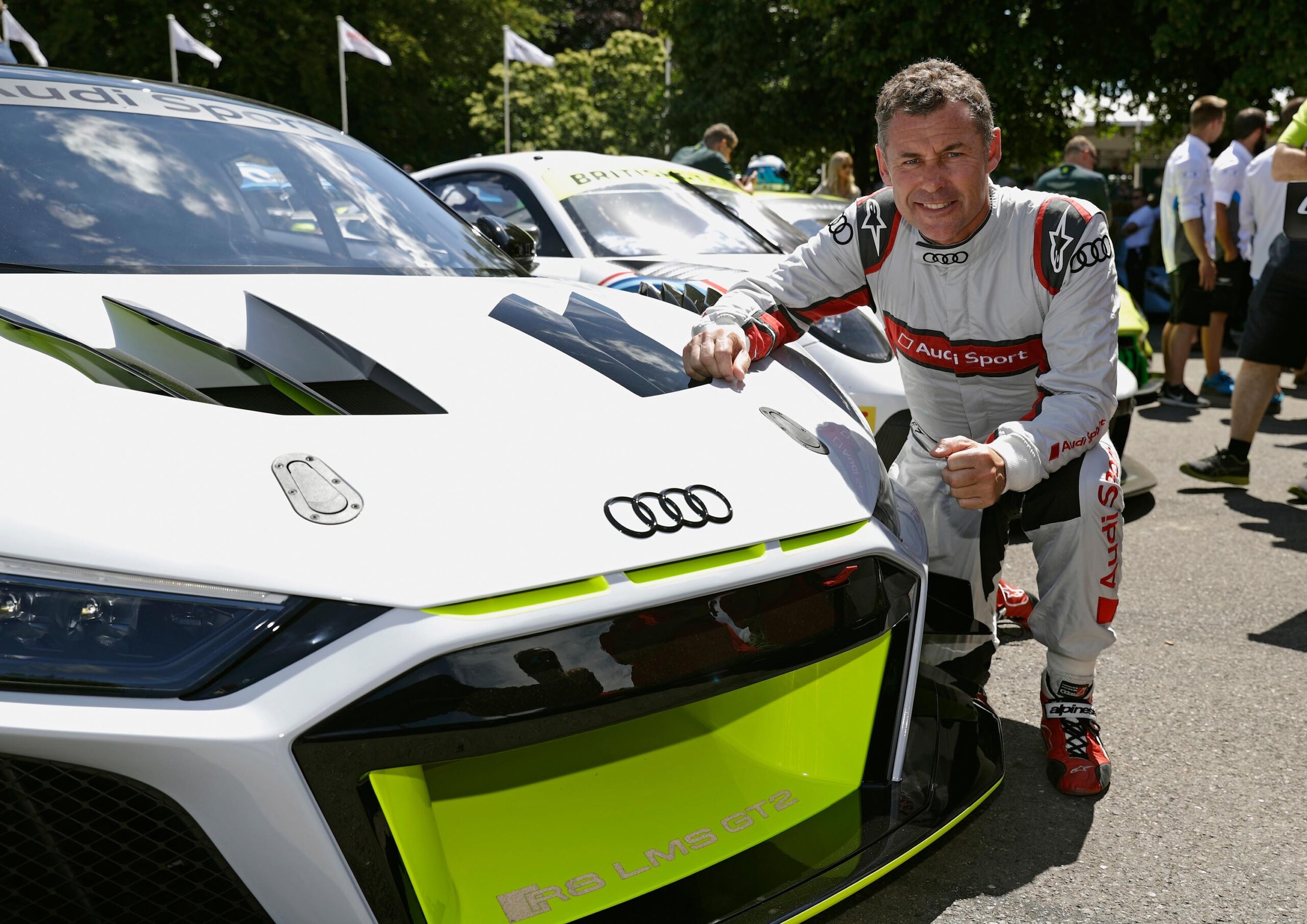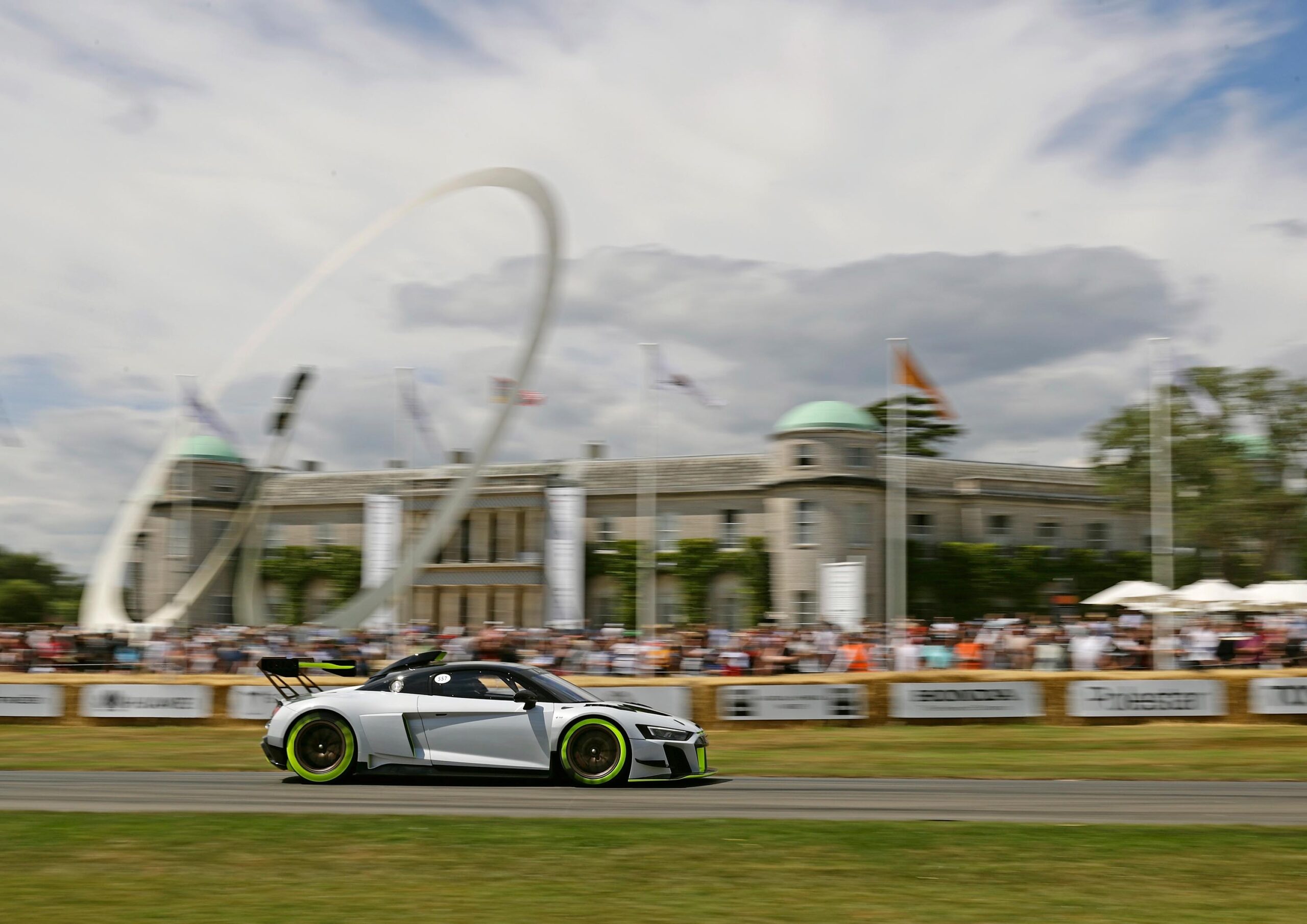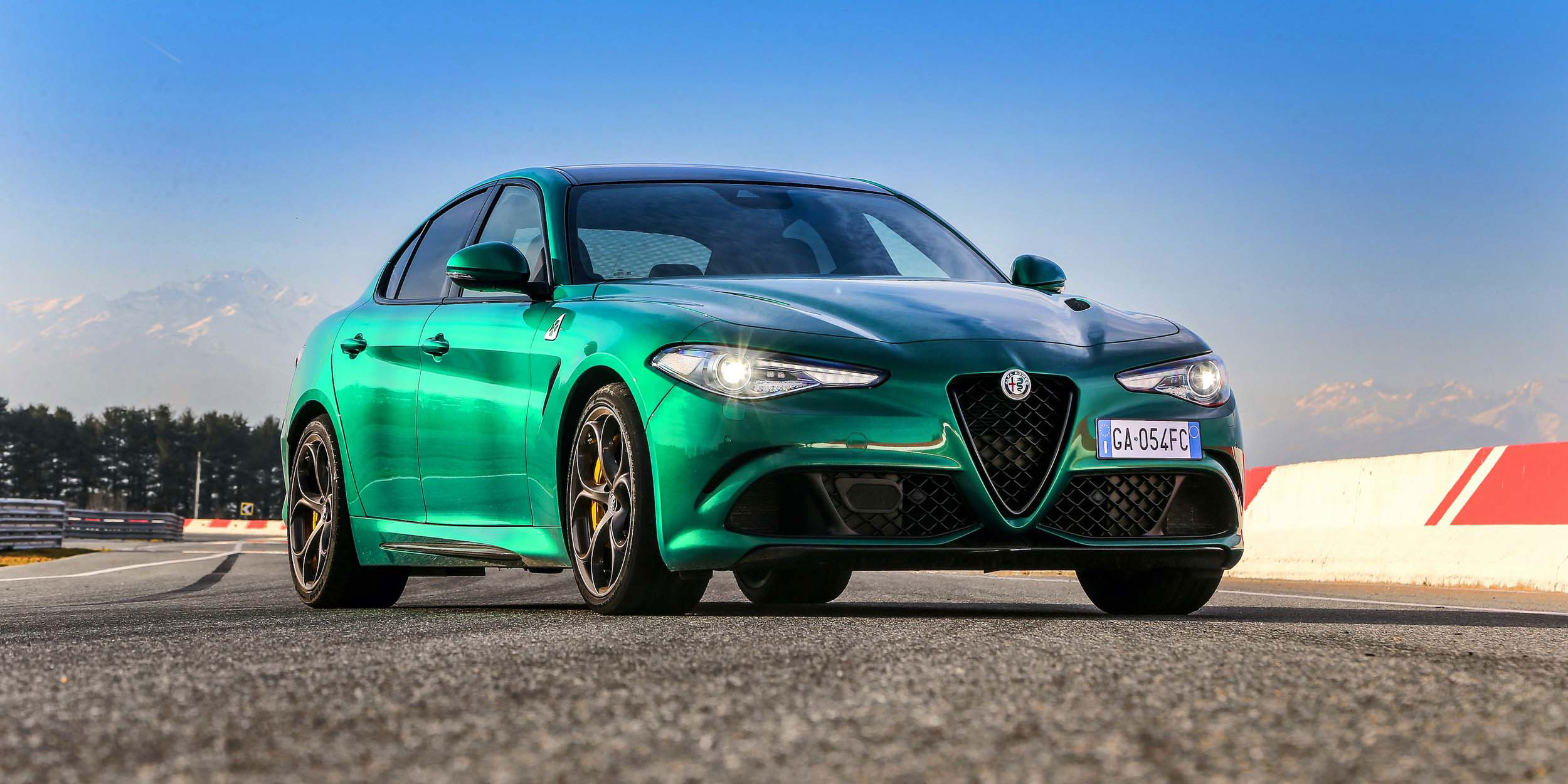Fascinating Audi R8 LMS GT2 completes model range
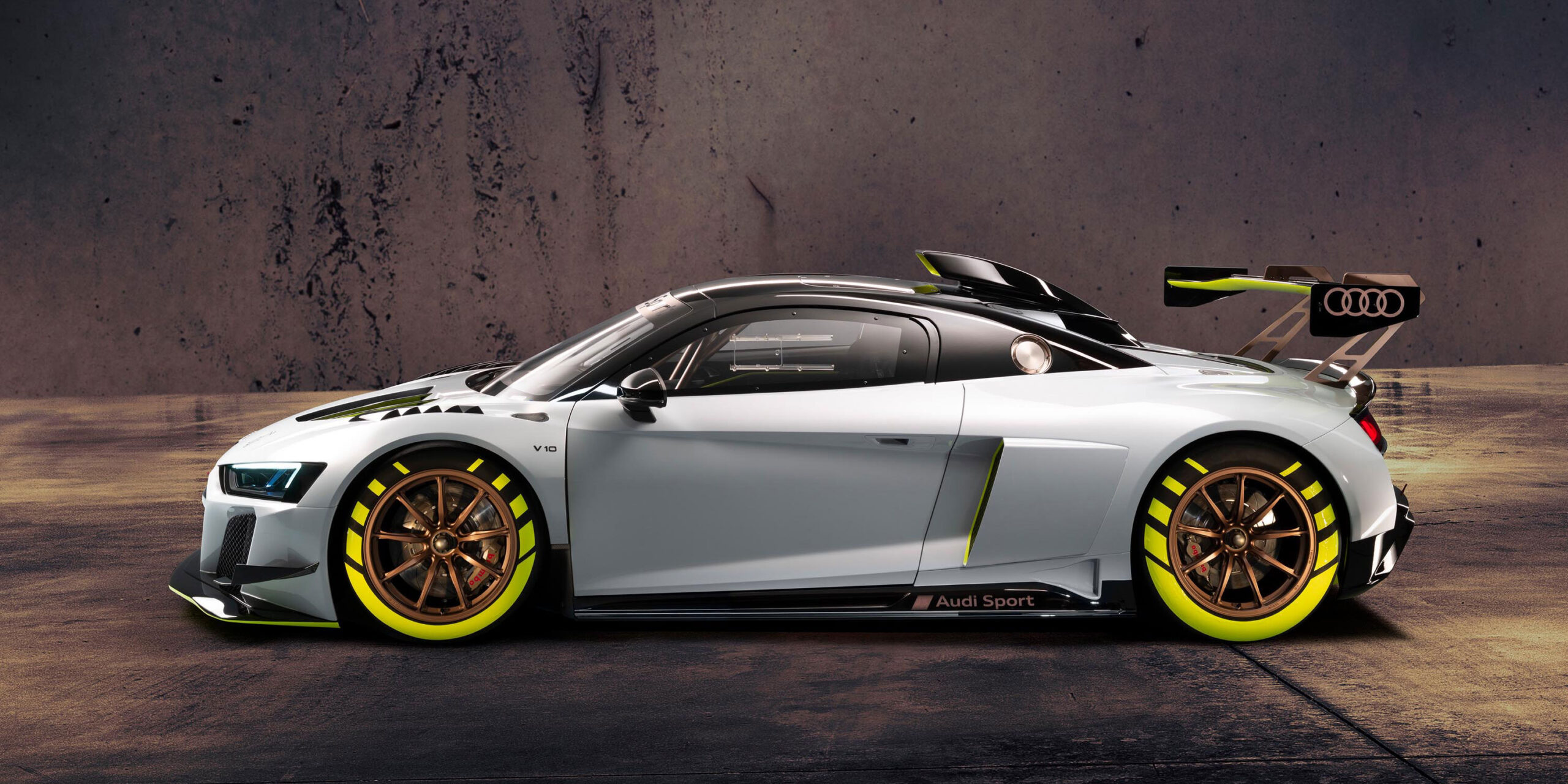
July, 2019 – The racing family of the Audi R8 LMS has received a powerful addition: The new Audi R8 LMS GT2 marks the top end of the range in terms of engine power and top speed. The GT2 concept stands for a unique balance of fascination and lap times that is specifically tailored to suit the needs of gentlemen drivers. As a result, another business segment is opening up for Audi Sport in international GT racing with new opportunities and target groups.
For the first time in the history of Audi Sport customer racing, a race car exists before the relevant championship begins: Audi Sport is presenting the R8 LMS GT2 as early as in mid-2019 for a category that will only come to life in the 2020 season. With it, the brand’s offering has now grown to four models. Besides the GT3 and the GT4 versions of the Audi R8 LMS the Audi RS 3 LMS touring car ranks among the world’s most popular and successful customer racing models bearing the four rings.
The Audi R8 LMS GT2 is almost a little reminiscent of the past: The slim shape of the cockpit and the bodywork featuring the proportions of the Spyder, the spectacular air scoop above the roof, protruding sideblades and the flared fenders emphasize traditional sports car characteristics. The most powerful evolution of the V10 engine with 470 kW (640 hp) has been designed for natural aspiration without an air restrictor. Visually and acoustically, the Audi R8 LMS GT2 exudes a unique fascination in the style of legendary sports cars of the past. At the same time, however, the new race car is equipped with state-of-the-art technology and stands for maximum safety.
The GT2 concept addresses drivers who appreciate the high longitudinal dynamics of powerful sports cars. Both in the future GT2 racing competitions and on Track Days, this new type of race car opens up a uniquely fascinating dimension without competing with current GT3 models in terms of lap times. “In this way, we have created a car specifically for gentleman drivers who have been the backbone of GT racing for decades,” says Chris Reinke, Head of Audi Sport customer racing. “Modern GT3 race cars have increasingly evolved into a class for pros. With the Audi R8 LMS GT2, we are now closing this gap and making a car available that is tailored to meet the needs of this customer group.” Selling for 338,000 euros (plus VAT), the new race car is priced between Audi Sport’s GT4 and GT3 models and can now be ordered. Audi Sport will deliver the first race cars before the end of 2019.
“FASCINATION GALORE”
The Head of Audi Sport customer racing talks about the new Audi R8 LMS GT2 for a new racing class.
You have unveiled the third derivative of the Audi R8 for racing. What is so fascinating about this new class?
The new GT2 class has the potential to fill a gap. Eleven years ago, we entered GT3 racing, which has evolved into a highly professional category. The expense incurred by drivers and teams is high, and racing there is not easy for amateurs and gentlemen. We also offer an attractive and globally successful product for the GT4 class, the Audi R8 LMS GT4. It marks the entry level of GT racing. A gap certainly still exists between these two classes: the new generation of GT2 race cars achieves even higher top speeds than a GT3 model and nearly identical lap times. This is ideal for gentlemen drivers: its longitudinal dynamics stands for a new experience with Audi and lateral dynamics does not put excessive demands even on amateurs. Plus, the new Audi R8 LMS GT2 visually and acoustically exudes fascination galore.
When and where are we going to see the new Audi R8 LMS GT2 in action?
At this juncture, there are no championships yet, but international series are being planned at least in Europe and in North America. Stéphane Ratel Organisation (SRO) has established itself as a worldwide architect of GT racing over the past quarter of a century and created many attractive platforms in America, Europe and Asia, plus even a global racing series in the form of the Intercontinental GT Challenge. I’m sure that SRO will make the GT2 class a success as well.
Who are your customers?
In our view, the customer spectrum of the new GT2 class differs from the GT3 or GT4 categories. Besides pure racing, it opens up new fields: Track Days provide an elegant escape from everyday life for many high-performance sports car enthusiasts without requiring them to immediately tackle the sporting and scheduling challenges of an entire racing season. Such Track Days now exist on many legendary circuits. In the form of the Race Resorts in Europe and in America, the next exciting trend has evolved. Owners of super sports cars and race cars can regularly drive on their favorite tracks and even create events of their own. We also have many other ideas in the back of our mind to make the Audi R8 LMS GT2 a desirable sports car.
THE MOST POWERFUL AUDI R8 LMS OF ALL TIME
Audi is ready for a new category in motor racing: The Audi R8 LMS GT2 stands for several superlative features in Audi Sport customer racing’s program. With 470 kW (640 hp), it is by far the most powerful sports car in the eleven-year history of the customer racing program. The race car achieves its specific power output of 123 horsepower/per liter of displacement with a near-production-level 5.2-liter naturally aspirated V10 engine. With it, the weight-to-power ratio of the Audi R8 LMS GT2 amounts to some 2.1 kg/hp. From a historical perspective, in about four decades, there has never been an Audi Sport race car with a naturally aspirated engine with such a favorable ratio between homologation weight and engine power.
Finally free: Audi Sport delivers the fascinating V10 engine in the GT2 model in a way that allows it to naturally aspirate air totally unrestricted also in racing and thus achieves its so far highest power output. Stéphane Ratel Organisation (SRO), which is responsible for the current GT2 regulations, gives center stage to the weight-to- power ratio as a leveling factor. Thus, with some 2.1 kg/hp, a balance is to be created between GT2 race cars using naturally aspirated engines and nominally clearly more powerful models with turbocharged engines.
This idea aims to close a gap in international GT racing. Audi Sport customer racing has been present in GT3 racing with the R8 LMS since as far back as 2009 and in the GT4 entry-level category since 2018. With very high aerodynamic downforce and ample pedigreed racing technology, the GT3 model, in terms of expense, setup and vehicle control, tends to address pros. The GT4 category offers young drivers being promoted from lower categories, as well as amateurs and gentlemen, a GT race car that is easy to control and very economical in terms of purchasing costs. While the GT2 race car outperforms both models with regard to engine power and top speed, its concept is designed to be nearly as fast as a GT3 when it comes to lap times. Hence its high longitudinal dynamics with limited lateral acceleration primarily addresses gentlemen drivers. This is precisely the target group for which the new GT2 class has been created.
In terms of technology, the Audi R8 LMS GT2 is based on the production version. The Audi Space Frame (ASF) with its intelligent material mix of aluminum and CFRP forms the basic structure of the race car, while a steel roll cage provides the required safety in racing. The geometry of the chassis corresponds to the Spyder version, just like the door cut-out. The extruded profiles in the roof area have been adopted from the Coupé. The cockpit section is completed by a slim-tailored hard top that gives the bodywork a unique, lean-sculptured look. Like the other body parts, it is made of CFRP for weight reasons. The cage consisting of tubes that, compared to the GT4 model, have a lower wall thickness but high strength due to higher-grade steel, additionally reduces mass. With a dry weight of 1,350 kilograms, the Audi R8 LMS GT2 tips the scales at 100 kilograms less than, for instance, the GT4 version.
Aerodynamically, the GT2 race car clearly differs from its siblings. Healthy temperature management of the engine is guaranteed by the voluminous radiator at the front end with CFD-optimized air flow channels. Unlike the GT3 and GT4, the vents are on the right and left, causing the air to flow past the windshield in order to avoid thermal conflicts with the engine’s air intake on the roof. The sideblades in front of the rear wheels follow the form prescribed by the R8 Spyder. However, they expose a larger cross section for air intake. A new front splitter, CFRP underfloor sections and a rear diffusor featuring the well-known GT4 geometry, but made of CFRP in the GT2 model, channel the air underneath the race car. The innovative rear suspension of the rear wing enhances air flow to the car and generates further downforce on the rear axle.
The wheel suspension with double wishbones front and rear as a pure racing suspension has been redesigned for weight reasons. Audi Sport combines new hub carriers and wishbones with the brake calipers of the GT3 version on the front axle and the GT4 brake calipers on the rear axle. The suspension struts have been adopted from the same modular kit as their counterparts for GT3 and GT4. In the steering system with its electrohydraulic servo pump, Audi uses synergies from the GT4 modular kit.
Audi Sport has upgraded the electronic architecture including the Anti-Lock Braking System (ABS), Traction Control (ASR) and the Electronic Stability Program (ESP) versus the GT4 model. New software enables a four-level adjustment of the systems and is in line with the needs of the field of application.
Like the power-plants of the GT3 and GT4 models, the naturally aspirated V10 engine originates from production at the Győr site in Hungary. The engineers essentially achieve the higher output of the 5.2-liter engine to 470 kW (640 hp) by means of modified engine management software and the conspicuous air intake plenum above the roof. It guarantees a ram-air intake effect with measurably increased power output. Strictly in technical terms, the GT3 unit with up to 430 kW (585 hp) has been the most powerful engine in Audi Sport’s model range up to now. However, due to regulatory restrictions, this GT3 engine is only allowed to mobilize about 368 kW (500 hp). So, factually, the Audi R8 LMS GT2 puts some 28 percent more power on the tarmac. Audi combines the GT2 engine with the S tronic seven-speed double clutch transmission which the driver operates by means of paddle shifters in the steering wheel. It has been used with great success in GT4 racing in sprint and endurance events.
In terms of safety, the Audi R8 LMS GT2 is top-class too. The Audi Protection Seat PS 3 optimally surrounds and supports the driver, while safety nets on the sides provide another increase in protection. The fire extinguishing system and six-point harnesses satisfy the high FIA standards. The safety fuel cell matches the design in the GT4 model, but has a 15-liter catch tank with a fill level sensor. A quick-refueling valve for endurance events can be ordered as an option. The safety steering column is adjustable in height and length and the pedals with their quick-adjustment mechanism sit on rails. Consequently, a precise seating position can be individually set for any physique. The rescue hatch in the roof facilitates access for the extrication team in the event of an accident. In this way, it makes it possible to remove the helmet of the driver in need of help and to apply a Kendrick Extrication Device for stabilization. The windshield and the side windows are made of lightweight and strong Makrolon. The camera-based digital rear-view mirror is new because the race car has no rear window due to the voluminous intake system. The construction of the doors is new too. They are made of carbon fiber and together with the CFRP-AFRP side impact protection with aluminum honeycomb that has been mandatory since 2019 satisfy the latest safety requirements for side impact protection.
This comprehensive package of power and performance, fascination and safety predestines the Audi R8 LMS GT2 as an ideal race car for gentlemen drivers and automobile enthusiasts who would like to call a future collector’s item their own.
TECHNICAL DATA
| Model | Audi R8 LMS GT2 (2019) |
|---|---|
| Vehicle | |
| Vehicle model | Sports car according to SRO GT2 regulations |
| Bodywork | Audi Space Frame (ASF) featuring an aluminum-CFRP hybrid design with steel roll cage, CFRP and aluminum ground-effects components |
| Safety concept | Energy-absorbing aluminum crash structures front and rear. Rescue hatch in the roof |
| Engine | |
| Type | V10 engine, 90-degree cylinder angle, four valves per cylinder, DOHC, gasoline direct injection, emission control system using two exhaust gas catalytic converters for racing |
| Engine management | 2 x Bosch MED 17 (master slave concept) |
| Engine lubrication | Dry sump (adopted from production) |
| Cubic capacity | 5,200 cc |
| Power output | 470 kW (640 hp) |
| Torque | More than 550 Nm |
| Drive train/transmission | |
| Type of drive | Rear-wheel drive, traction control (ASR), ESP |
| Clutch | Two electrohydraulically operated multi-plate clutches in an oil bath |
| Transmission | S tronic seven-speed double-clutch transmission with paddle shifters |
| Differential | Mechanical limited-slip differential |
| Drive safts | Constant velocity joint shafts |
| Suspension/steering/brakes | |
| Steering | Electrohydraulic rack and pinion steering, multi-functional steering wheel |
| Suspension | Double wishbones front and rear, struts with coil springs and adjustable dampers, plus adjustable stabilizers front and rear |
| Brakes | Hydraulic dual-circuit braking system, steel brake discs front (380 x 34 mm) and rear (350 x 32 mm), racing ABS |
| Rims | Forged aluminum rims, front 12 x 18 inches, 40 offset, rear 13 x 18 inches, 43 offset |
| Tires | Front 325-660/18, rear 325-710/18 |
| Weight/dimensions | |
| Length/width/height | 4,568 mm/1,995 mm/1,280 mm |
| Dry weight | 1,350 kg |
| Fuel cell capacity | 110 l (FT3 safety fuel tank) |
| Equipment | |
| Fire extinguishing system | Extinguishing system acc. to FIA Standard 8865-2015 |
| Controls | Height-and length-adjustable safety steering column, quick-adjustable foot pedals mounted on rails |
| Seat system | Audi Protection Seat PS 3 |
PROGRAM ON FOUR PILLARS
Audi’s customer racing program began in 2009. Initially, Audi Sport customer racing with the R8 LMS focused on the globally growing GT3 category. At the end of 2016, the teams were able to purchase the Audi RS 3 LMS for the TCR touring car class for the first time. Since the end of 2017, the Audi R8 LMS GT4 has been an additional pillar of the customer racing program. In 2019, Audi Sport presents the R8 LMS GT2. Hence the current program rests on four pillars.
The portfolio of Audi Sport customer racing is diverse, and the product range modern and closely oriented to the needs of the teams. The Audi RS 3 LMS delivering up to 257 kW (350 hp) nationally and internationally offers professional opportunities to enter touring car racing at moderate costs. 2019 marks its third season. The Audi R8 LMS GT4 targets amateur drivers who would like to contest sprint or endurance races with an attractive, production-based sports car. In 2018, its debut year, teams won ten worldwide titles with the sports car that delivers up to 364 kW (495 hp). The GT3 model of the Audi R8 LMS presents itself as a new version in 2019. The race car delivering up to 430 kW (585 hp) is available as an evolution. The teams benefit from even better drivability. The Audi R8 LMS GT2, presented in 2019 as well, with power output of 470 kW (640 hp) complements the lineup upward. It specifically addresses gentleman drivers and sports car enthusiasts who thus also experience a new form of fascination on Track Days.
Audi is one of the most attractive manufacturers in international customer racing. Between 2009 and 2018, Audi Sport customer racing built a total of 563 race cars across all model ranges. Since 2015, Audi Sport customer racing has presented at least one new or updated model each year. The program that is both a racing and business success has become firmly established around the globe. In addition to the products, support is another key selling point for many teams: five contractual partners – two in Asia, one in Australia, one in the United States and one in Canada – cover the regional supply and support to the teams around the world while Audi Sport customer racing based in Neuburg an der Donau takes care of the European markets.





